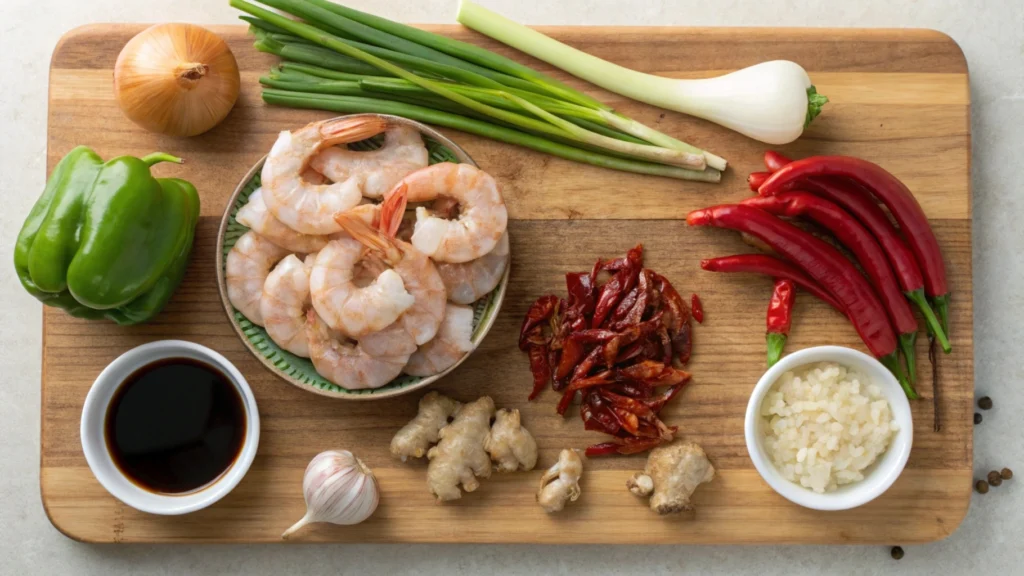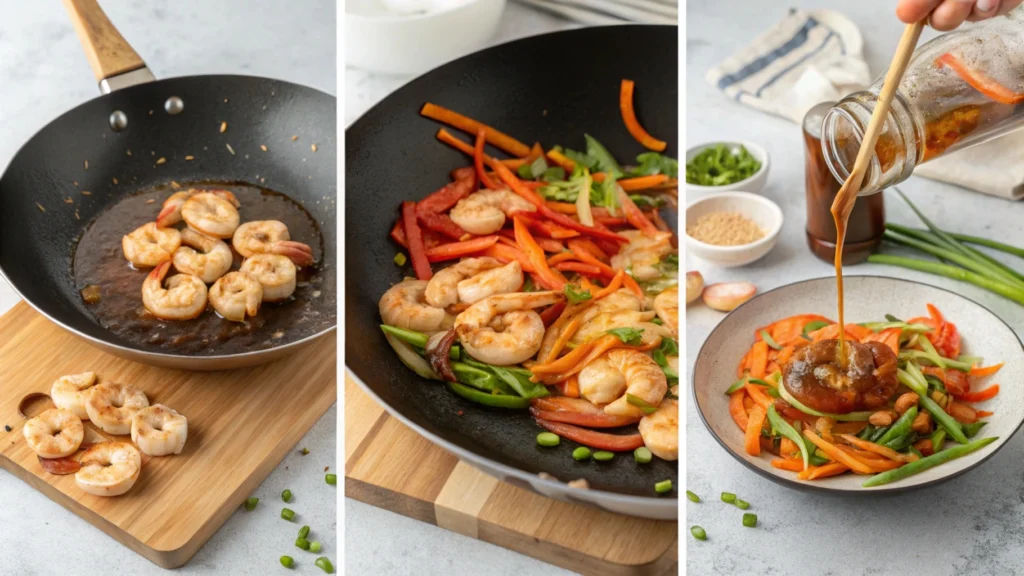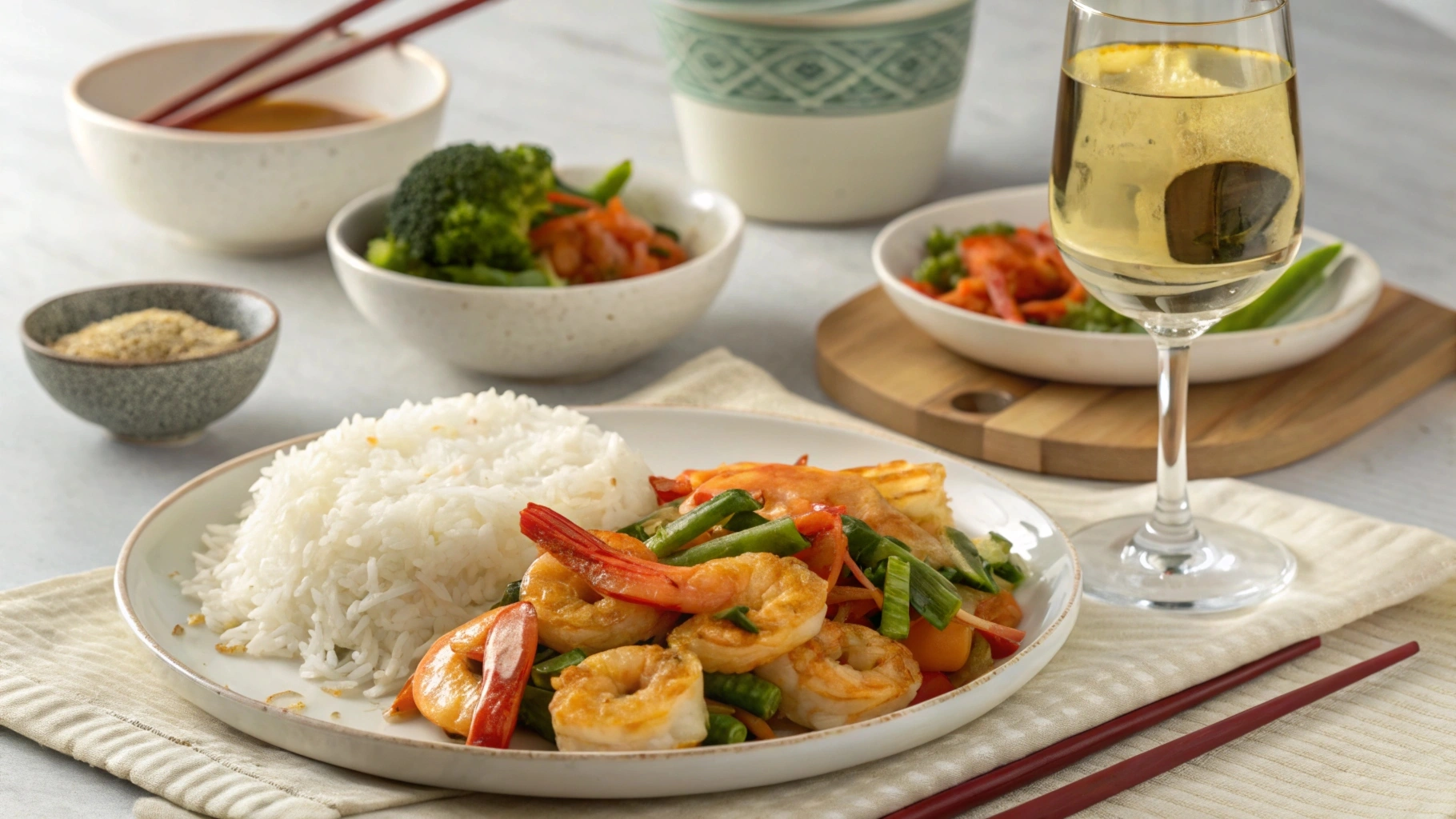Have you ever tasted a dish that bursts with bold flavors and leaves a fiery tingle on your tongue? That’s the magic of Hunan Shrimp, a signature dish from China’s Hunan province. Known for its spicy and savory profile, this dish is a favorite among spice enthusiasts and seafood lovers alike. Hunan cuisine stands out for its use of fresh ingredients and bold seasonings, and Hunan Shrimp exemplifies this tradition.
In this article, we’ll dive deep into everything you need to know about Hunan Shrimp. From its origins to its ingredients and step-by-step preparation, we’ll explore what makes this dish a culinary masterpiece. Whether you’re a seasoned cook or just someone curious about this flavorful dish, you’re in for a treat. Let’s get started!
perfect for the region’s cold winters.
Ingredients in Hunan Shrimp
Hunan Shrimp relies on simple yet bold ingredients to deliver its signature flavor. Whether you’re cooking it at home or ordering it at a restaurant, understanding the key ingredients helps appreciate the dish’s rich and complex taste.

Core Ingredients
- Shrimp:
- Fresh, medium-to-large shrimp work best. They should be deveined, peeled, and tail-on or tail-off depending on preference.
- The shrimp’s delicate sweetness balances the bold heat of the sauce.
- Chilies:
- Fresh chilies: Add vibrant color and a crisp texture.
- Dried red chilies: Provide the deep, smoky heat that defines Hunan Shrimp.
- Vegetables:
- Bell peppers, celery, and scallions are commonly used to add crunch and complement the spicy sauce.
- Optional additions include carrots or snap peas for sweetness.
- Aromatics:
- Garlic and ginger: These two ingredients create the fragrant base of the dish.
- Hunan Chili Sauce:
- A combination of chili paste, soy sauce, vinegar, and sugar creates the dish’s tangy, spicy, and slightly sweet sauce.
Signature Hunan Chili Sauce
The heart of Hunan Shrimp is its sauce. Here’s what you’ll need to recreate it:
- Chili paste: Provides a concentrated spicy flavor.
- Soy sauce: Adds depth and saltiness.
- Black vinegar: Balances the heat with a tangy undertone.
- Shaoxing wine: Enhances the umami flavor (optional but highly recommended).
- Sugar: A pinch of sugar balances the bold spices for a harmonious flavor.
Substitutions for Dietary Preferences
Cooking Hunan Shrimp at home allows for flexibility:
- Vegetarian/Vegan: Replace shrimp with tofu or plant-based shrimp alternatives.
- Gluten-Free: Use tamari or a gluten-free soy sauce.
- Lower Heat Tolerance: Reduce the amount of chili paste or substitute with mild chili flakes.
The Flavor Profile of Hunan Shrimp
Hunan Shrimp is a culinary delight celebrated for its bold, fiery, and well-balanced flavors. The dish perfectly combines heat, tanginess, and a subtle sweetness, offering a taste experience that excites the palate. Let’s take a closer look at the elements that make its flavor profile unique.
**Bold and
The Flavor Profile of Hunan Shrimp
Hunan Shrimp is a culinary delight celebrated for its bold, fiery, and well-balanced flavors. The dish perfectly combines heat, tanginess, and a subtle sweetness, offering a taste experience that excites the palate. Let’s take a closer look at the elements that make its flavor profile unique.
Bold and Spicy Notes
The hallmark of Hunan Shrimp is its unapologetic spiciness. Dried red chilies and chili paste dominate the dish, bringing a bold heat that’s layered with smoky and earthy undertones. Unlike the numbing effect of Sichuan peppercorns, the heat in Hunan Shrimp is direct and sharp, making it a favorite for spice enthusiasts.
Tangy and Umami Flavors
To balance the spice, Hunan Shrimp features tangy notes from black vinegar and a hint of sweetness from sugar. Soy sauce and Shaoxing wine add a savory umami depth, creating a harmonious interplay of flavors.
Crisp and Fresh Textures
The dish isn’t just about its sauce. The inclusion of fresh vegetables like bell peppers and celery adds a satisfying crunch, contrasting beautifully with the tender and juicy shrimp. This combination of textures enhances the overall eating experience.
Aromatic Undertones
The ginger and garlic used as aromatics lend the dish a fragrant base. These ingredients not only amplify the flavors of the shrimp and sauce but also provide a warm, savory backdrop that ties all elements together.
How to Prepare Hunan Shrimp at Home
Making Hunan Shrimp at home is simpler than you might think. By following these step-by-step instructions, you can recreate this restaurant favorite in your own kitchen.

Ingredients You’ll Need
- For the Shrimp:
- 1 lb of shrimp, peeled and deveined
- 1 tbsp cornstarch
- Salt and pepper to taste
- For the Sauce:
- 2 tbsp chili paste
- 1 tbsp soy sauce
- 1 tbsp black vinegar
- 1 tsp sugar
- 1 tbsp Shaoxing wine (optional)
- For the Stir-Fry:
- 2 tbsp vegetable oil
- 3 garlic cloves, minced
- 1-inch piece of ginger, grated
- 1 red bell pepper, sliced
- 1 celery stalk, sliced
- 5–6 dried red chilies
Step-by-Step Cooking Instructions
- Prep the Shrimp:
- Toss the shrimp in cornstarch, salt, and pepper. This coating helps create a slight crispness when stir-fried.
- Make the Sauce:
- In a small bowl, mix the chili paste, soy sauce, black vinegar, sugar, and Shaoxing wine. Set aside.
- Cook the Shrimp:
- Heat 1 tbsp of oil in a wok or skillet over medium-high heat. Add the shrimp and cook until pink and slightly crisp on the edges, about 2 minutes per side. Remove and set aside.
- Stir-Fry the Vegetables:
- Add the remaining oil to the wok. Stir-fry garlic, ginger, and dried red chilies until fragrant, about 30 seconds.
- Add the bell pepper and celery, cooking for 2–3 minutes until slightly tender but still crisp.
- Combine and Serve:
- Return the shrimp to the wok and pour in the sauce. Toss everything together until the shrimp and vegetables are well coated.
- Serve hot with steamed rice or noodles.
Variations of Hunan Shrimp
Hunan Shrimp’s versatility makes it a beloved dish across cultures, inspiring numerous adaptations to suit dietary preferences, available ingredients, and regional tastes. Let’s explore some popular variations and how they differ from the traditional recipe.
Hunan Shrimp with Vegetables
Adding vegetables to the dish not only enhances its nutritional value but also balances the bold heat with refreshing textures.
- Common Additions: Broccoli, snow peas, zucchini, or mushrooms are great options that complement the spicy sauce.
- Cooking Tip: Stir-fry the vegetables separately to retain their crunch before combining them with the shrimp.
Vegan or Vegetarian Hunan Shrimp
For those avoiding seafood or following plant-based diets, it’s easy to recreate the essence of Hunan Shrimp without using shrimp.
- Substitutes for Shrimp:
- Tofu: Firm or extra-firm tofu works well to absorb the bold flavors of the sauce.
- Plant-Based Shrimp: Many brands now offer vegan shrimp alternatives made from soy or konjac.
- Additional Vegetables: Eggplant, cauliflower, or green beans can be used as the primary ingredient.
Restaurant-Style Hunan Shrimp
Recreating the flavors of restaurant-style Hunan Shrimp at home involves replicating the high-heat cooking techniques and presentation.
- Secret Tips:
- Use a wok and cook over high heat to achieve the smoky, charred flavors associated with restaurant dishes.
- Garnish with freshly chopped scallions or sesame seeds for a professional touch.
- Sauce Adjustments: Many restaurants use a slightly sweeter sauce to cater to Western palates. Add an extra teaspoon of sugar if desired.
Fusion Hunan Shrimp Dishes
Modern interpretations of Hunan Shrimp blend its signature flavors with international cuisines:
- Hunan Shrimp Tacos: Serve the shrimp in warm tortillas with shredded cabbage and a drizzle of lime crema for a fusion twist.
- Hunan Shrimp Pasta: Toss the shrimp and sauce with spaghetti or rice noodles for a creative main dish.
Hunan Shrimp in Restaurants
Hunan Shrimp is a popular menu item in Chinese restaurants worldwide. Known for its vibrant flavors and visually appealing presentation, it’s a dish that often attracts both seafood lovers and spice enthusiasts. Here’s what to expect when ordering Hunan Shrimp in a restaurant and how to spot an authentic preparation.
How It’s Commonly Served
- Plated Elegantly:
- Restaurants often serve Hunan Shrimp with the shrimp arranged over a bed of steamed white rice, garnished with scallions or sesame seeds.
- Accompanying stir-fried vegetables like bell peppers and broccoli are included for a balanced presentation.
- Family-Style:
- In many traditional Chinese restaurants, dishes are served family-style, with Hunan Shrimp placed on a large platter for sharing.
- Diners can pair it with other dishes such as fried rice, lo mein, or vegetable stir-fries.
- As Part of a Combo:
- Some restaurants include Hunan Shrimp in combination platters, offering it alongside other iconic dishes like egg rolls or hot and sour soup.
How to Identify Authentic Hunan Shrimp
Not all Hunan Shrimp dishes are created equal. Here’s how to tell if the one you’re enjoying is an authentic representation of the dish:
- Bold Spiciness: Authentic Hunan Shrimp will have a noticeable heat from chilies and chili paste. If it lacks spiciness or is overly sweet, it may be a Westernized version.
- Tangy Sauce: A balance of vinegar’s tanginess and soy sauce’s umami is essential. The sauce should not be overly thick or gloopy.
- Fresh Ingredients: Look for vibrant, fresh vegetables and tender shrimp cooked just right. Authentic versions focus on fresh, high-quality ingredients rather than heavy reliance on pre-made sauces.
Dining Tips for Enjoying Hunan Shrimp
- Pair It Right:
- Ask for steamed or fried rice to accompany the dish, as it helps balance the spiciness.
- Light soups like wonton soup or hot and sour soup make great starters.
- Adjust the Spice Level:
- If you’re unsure about your spice tolerance, ask the restaurant to tone down the heat. Most chefs are happy to adjust the chilies to suit your preference.
- Order Family-Style:
- To fully experience the flavors of Hunan cuisine, pair Hunan Shrimp with other dishes like Kung Pao Chicken or Mapo Tofu.
Nutritional Benefits
Hunan Shrimp is not just a flavorful dish; it’s also packed with nutritional benefits that make it a healthy option for seafood lovers. Let’s explore the key health advantages of this spicy and savory dish.
High Protein Content
Shrimp is an excellent source of lean protein, which is essential for muscle growth, repair, and overall body function.
- Protein Per Serving: A standard serving of Hunan Shrimp provides about 20–25 grams of protein, depending on the portion size.
- Low in Fat: Shrimp contains minimal saturated fat, making it an ideal choice for those seeking a low-fat, high-protein meal.
Rich in Vitamins and Minerals
- Shrimp-Specific Nutrients:
- Vitamin B12: Supports nerve function and red blood cell production.
- Selenium: Acts as a powerful antioxidant to protect against cell damage.
- Omega-3 Fatty Acids: Promotes heart and brain health.
- Vegetables’ Nutritional Contribution:
- Bell peppers and celery are rich in vitamins A and C, which boost immunity and improve skin health.
- These vegetables are also high in dietary fiber, aiding digestion.
Low in Carbohydrates
Hunan Shrimp is naturally low in carbs, making it a great choice for low-carb and keto diets.
- By avoiding added sugars or thickening agents like cornstarch in the sauce, the dish can be tailored further for those monitoring their carbohydrate intake.
Supports Weight Management
The combination of high protein, low fat, and nutrient-dense vegetables makes Hunan Shrimp a satisfying meal that helps control hunger and maintain energy levels.
- Caloric Breakdown: A single serving of Hunan Shrimp typically contains 200–300 calories, making it a light yet filling option.
Spice Benefits
The chilies in Hunan Shrimp offer more than just heat; they also have potential health benefits:
- Boosts Metabolism: Capsaicin, the compound in chilies responsible for their spiciness, can temporarily boost metabolic rate.
- Anti-Inflammatory Properties: Capsaicin has been studied for its role in reducing inflammation in the body.
Pairing Suggestions
Best Side Dishes
- Steamed or Fried Rice:
- Why It Works: The neutral flavor of steamed rice balances the spiciness of Hunan Shrimp, while fried rice adds an extra layer of texture and taste.
- Variations: Jasmine rice, brown rice, or cauliflower rice for a low-carb option.
- Noodles:
- Popular Choices: Lo mein or stir-fried egg noodles are perfect for soaking up the tangy sauce of Hunan Shrimp.
- For a Twist: Opt for glass noodles or soba noodles to add an interesting texture.
- Vegetable Stir-Fry:
- Complementary Vegetables: Broccoli, snap peas, and carrots offer a sweet and crunchy contrast to the shrimp.
- Sauce Pairing: Lightly season the vegetables with garlic and soy sauce to avoid overpowering the dish.
- Dumplings or Spring Rolls:
- Crispy spring rolls or dumplings make for an excellent appetizer or side, offering a mild and savory taste that complements the spicy shrimp.
Beverage Pairings
- Wine:
- White Wine: A chilled Riesling or Sauvignon Blanc pairs well with the dish’s spiciness and tangy flavors.
- Red Wine: A light-bodied Pinot Noir offers a fruity contrast without clashing with the heat.
- Beer:
- Light Beers: Lagers and pilsners provide a refreshing palate cleanser.
- Craft Options: Wheat beers or fruity IPAs complement the chili heat.
- Non-Alcoholic Beverages:
- Iced Tea: A sweetened or unsweetened iced tea balances the spiciness.
- Sparkling Water: Add a twist of lime for a refreshing option.
- Coconut Water: Its natural sweetness and cooling properties make it a perfect pairing for spicy dishes.
Sauce Complements
- Soy Sauce and Chili Oil:
- Serve these on the side for diners who want to enhance the flavor or spice level of their meal.
- Peanut Sauce:
- A mild, nutty sauce can add a unique element, particularly if you’re pairing Hunan Shrimp with noodles or satay-style appetizers.
Regional Variations
Hunan Shrimp’s spicy and savory profile has led to various adaptations across regions, blending traditional elements with local culinary influences. These variations reflect the dish’s versatility and global appeal.
Authentic Hunan Shrimp from China
In its home province of Hunan, the dish stays true to its roots with a focus on intense heat and fresh, local ingredients.
- Key Characteristics:
- The use of freshly harvested chilies, garlic, and ginger is paramount.
- Seasonal vegetables like lotus root or bamboo shoots are often included.
- The sauce is typically thinner, emphasizing the natural flavors of the ingredients.
- Traditional Cooking Methods:
- Wok-frying over high heat ensures the shrimp remain tender while the vegetables stay crisp.
- Minimal sugar is used, as authentic Hunan cuisine prioritizes savory and spicy over sweet.
Western Adaptations
In Western countries, Hunan Shrimp often takes on a slightly sweeter and less spicy profile to suit local palates.
- Common Modifications:
- More sugar or honey may be added to the sauce for balance.
- The dish is often served with more sauce, catering to diners who enjoy rich and thick textures.
- Substitutions like frozen shrimp or pre-packaged chili sauces make preparation easier.
- Restaurant Variations:
- Some Westernized versions include non-traditional vegetables like zucchini or snap peas.
- The dish may be served with fried rice or chow mein instead of plain steamed rice.
Fusion Versions and International Appeal
Hunan Shrimp’s bold flavors have inspired fusion dishes that incorporate elements from other cuisines.
- Hunan Shrimp Sushi Rolls:
- Shrimp coated in Hunan sauce is used as a topping for sushi rolls, paired with avocado and cucumber for balance.
- Tex-Mex Hunan Shrimp Tacos:
- The spicy shrimp is served in soft tortillas, topped with coleslaw and a drizzle of lime crema for a cross-cultural twist.
- Indian-Chinese Hunan Shrimp:
- In regions like India, the dish is often adapted to include curry leaves and additional spices, creating a fusion of Chinese and Indian flavors.
Why Regional Variations Matter
The way Hunan Shrimp is adapted globally highlights the dynamic nature of food. Each version tells a story of cultural exchange, personal preferences, and creative expression, making it a truly universal dish while honoring its Hunan roots.

